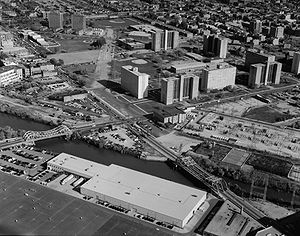
Housing Act of 1949
Encyclopedia

Fair Deal
The Fair Deal was the term given to an ambitious set of proposals put forward by United States President Harry S. Truman to the United States Congress in his January 1949 State of the Union address. The term, however, has also been used to describe the domestic reform agenda of the Truman...
.
Provisions
The main elements of the Act included:- providing federal financing for slum clearance programs associated with urban renewalUrban renewalUrban renewal is a program of land redevelopment in areas of moderate to high density urban land use. Renewal has had both successes and failures. Its modern incarnation began in the late 19th century in developed nations and experienced an intense phase in the late 1940s – under the rubric of...
projects in American cities (Title I), - increasing authorization for the Federal Housing AdministrationFederal Housing AdministrationThe Federal Housing Administration is a United States government agency created as part of the National Housing Act of 1934. It insured loans made by banks and other private lenders for home building and home buying...
(FHA) mortgage insurance (Title II), - extending federal money to build more than 800,000 public housing units (Title III)
- fund research into housing and housing techniques, and
- permitting the FHA to provide financing for rural homeowners.
Creation of the legislation
In the State of the Union address unveiling the Fair Deal, Truman observed that "Five million families are still living in slums and firetraps. Three million families share their homes with others." He also presented a policy statement on housing:In Congress, the bill was sponsored by Republican Sen. Robert Taft
Robert Taft
Robert Alphonso Taft , of the Taft political family of Cincinnati, was a Republican United States Senator and a prominent conservative statesman...
.
Legacy
The Act was of great importance in that it governed the way the immense financial resources of the federal government would shape the growth of American cities in the post-war era. For instance, in one survey of the top "influences on the postwar American metropolis," the FHA's mortgage financing program ranks second and urban renewal programs rank fourth. The law facilitated a rise in homeownership and the building of huge public housing projects that would become fixtures in many American cities.The legislation's legacy is mixed, particularly with regard to the success of the urban renewal and public housing elements. The government fell far short of its goal to build 810,000 units of new public housing by 1955, providing little aid to cities suffering from housing shortages. In fact, because of projects like Lincoln Center, a New York City cultural development including 4400 apartments for which 7000 apartments were torn down, the Act's urban redevelopment programs actually destroyed more housing units than they built.
Meanwhile, the massive urban redevelopment efforts prompted by the Act came under fire for poor planning, failings with regard to social equity and fairness, and sometimes corruption (see, e.g., Manhattantown
Manhattantown
Manhattantown, now known as Park West Village or West Park Apartments, was a massive urban renewal project in the Bloomingdale District section of New York City west of Central Park. It was funded by Title I of the Housing Act of 1949, which financed slum clearance under urban redevelopment...
). Urban renewal also came under fire for discriminating against minorities, in that it often resulted in minority-heavy slums being destroyed and replaced with more expensive housing or non-residential public works that were not accommodating to the original inhabitants. The slogan adopted by critics equated "urban renewal" with "Negro removal."
The federal government spent $13.5 billion on urban redevelopment and slum clearance projects between 1953 and 1986.

